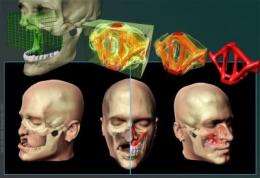High-performance engineering used to design facial bone replacements

Scientists are using the engineering technology behind the creation of high-performance aircraft components to design 3-D models for the replacement of delicate and complex facial bones lost to cancer surgery or trauma.
The researchers, combining engineering and plastic surgery expertise, have used a computational technique called topological optimization to design an experimental 3-D structure that can withstand the forces of chewing, facilitate speaking and swallowing, and replace large portions of the facial skeleton. The work is focused on the center of the face, home to the most complicated bony structures in the human head.
Eventually, the team plans to use tissue engineering techniques to grow bone around these lightweight structures and implant the new bone during facial reconstruction surgeries. The researchers predict that fully functional bone replacements based on these structural designs could be in use in operating rooms within 10 years.
The research, published this week in the online early edition of the Proceedings of the National Academy of Sciences, was led by Ohio State University researchers in collaboration with scientists from the University of Illinois.
Advances in reconstruction could reduce disfigurement among head and neck cancer patients and victims of such traumas as gunshot or blast wounds, including war injuries. The U.S. Department of Defense declared its interest in improving facial reconstruction with the 2008 establishment of the Armed Forces Institute of Regenerative Medicine.
Current plastic surgery techniques involve using a patient's own bones - typically portions of the fibula in the lower leg - to piece together a relatively crude bone replacement during facial reconstruction.
"The difference between what is done now and our design is that we take into account all of the loads on the structure. And this is not a generic shape. For each person, we could create a patient-specific design" said Alok Sutradhar, a postdoctoral researcher in plastic surgery at Ohio State and lead author of the paper describing the work.
Sutradhar is trained as an engineer, with a specialty in 3-D computational modeling and a background in working with multifunctional high-performance lightweight materials used in space shuttle tiles and other aircraft.
The application of his expertise to medicine is particularly rare, said Michael Miller, professor of surgery and director of the division of plastic surgery at Ohio State. "We are not aware of anyone else approaching facial bone defects using these methods," said Miller, a co-author of the paper.
The method, topological optimization, puts a computer to work to design the smallest structure needed to accommodate specific spatial boundaries and mechanical loads. The technique combines a series of mathematical equations with advanced 3-D imaging to produce a structure that takes into account both the space to be filled and space that must remain unoccupied to allow for such features as nasal passages and eyes.
"The purpose is to find the most optimized macrostructure to replace the missing bone. It would contain the minimum amount of tissue positioned in three-dimensional space and supported upon remaining uninjured portions of the facial skeleton," Sutradhar explained.
With the technology developed to date for this purpose, the researchers start with a sample MRI image of a damaged face to establish the outer boundaries of a rectangular space in which a replacement structure would be placed surgically. They specify spaces that must be left void, and then apply a number of mathematical equations that account for how strong the structure must be and how it should be shaped to support the skull and accommodate the loads of chewing and blunt pressure on the face.
In one of the first examples produced by the experimental computations, Sutradhar noted, the design resembled an outline of the bones of the sinus cavity. However, an exact replica of facial bones is not necessary or desirable for this work, researchers said.
"The idea is not to recreate normal anatomy. It is to recreate functional support that is alive and permanent that we will be able to place prosthetics on," Miller said.
With minimal constraints applied to these early designs, Sutradhar and colleagues next plan to add additional variables to the equations, such as structural requirements needed to support transplanted soft tissue or prosthetics.
Another important detail is determining the vascular needs for the tissue-engineered bone that would be grown around these model structures. Any bone used in facial reconstruction - that from a patient's own body or engineered from other biological materials - must be supported by a blood supply that is attached to blood vessels in the face during reconstruction to promote healing and keep the bone alive.
After adding more variables to the design process, the researchers plan to conduct feasibility tests of the structures, which will be made out of titanium. Neither this lightweight metal nor other synthetic material is suitable for permanent use in this type of reconstruction because the foreign substance can lead to infection, react poorly with soft tissues and erode, Miller said.
As a plastic surgeon specializing in reconstruction after extensive cancer surgery, Miller has been pursuing ways to grow new bone tissue for more than a decade. He and colleagues ultimately plan to use these new structures as models on which new bone material can be grown using a patient's own body as a bioreactor. The new bone would then be used as the basis for facial reconstruction.















